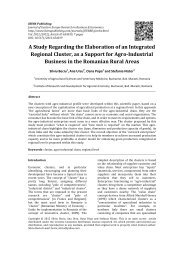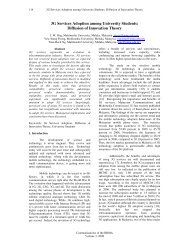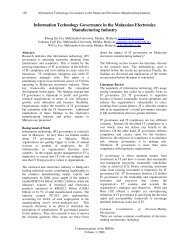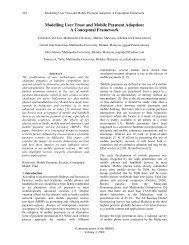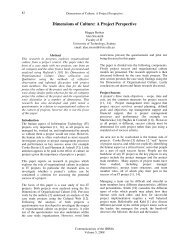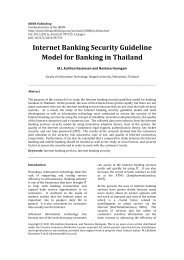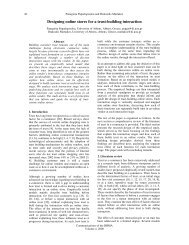Innovation Management: Types, Management ... - IBIMA Publishing
Innovation Management: Types, Management ... - IBIMA Publishing
Innovation Management: Types, Management ... - IBIMA Publishing
Create successful ePaper yourself
Turn your PDF publications into a flip-book with our unique Google optimized e-Paper software.
<strong>Innovation</strong> <strong>Management</strong>: <strong>Types</strong>, <strong>Management</strong> Practices and <strong>Innovation</strong> Performance 161<br />
In Services Industry of Developing Economie<br />
reveal about the degree of<br />
innovativeness and its impact on the<br />
performance of the organization. The<br />
effectiveness of the innovation is<br />
measured in terms of the responsive<br />
impact on the products and<br />
organizational processes which indicates<br />
the efficiency of innovation in the shape<br />
of organizational performance (G .Tor &<br />
L.Kathryn, 1994).<br />
Strategic direction is crucial to gain<br />
optimum benefits from innovation as it<br />
makes innovation the part of the<br />
organizational strategy. The degree to<br />
which this strategic vitality is recognized<br />
by the organizations can be judged by<br />
the quantum of responsibilities given to<br />
significant amount of staff in relation to<br />
their human resource and the verticals<br />
where that staff is placed in the<br />
organizational hierarchy (C. Angela, E.<br />
John, et al., 2001).<br />
This is the age of information<br />
technology, companies are changing<br />
rapidly and market competitiveness<br />
forces them to develop synergic relation<br />
between quality and productivity<br />
(Michael A. Allocca & Eric H. Kessler,<br />
2006).<br />
2.3 <strong>Innovation</strong> management practices<br />
The survey of large firms has proved<br />
that there are different requirements for<br />
managing radical and incremental<br />
innovations. Profitable radical<br />
innovations are more dominant in small<br />
medium enterprises as compared to large<br />
firms. Incremental innovations,<br />
involving improvements to processes,<br />
products and services in response to<br />
customer needs are focused (Oke A.,<br />
Burke G. et al., 2007).<br />
The greatest level of growth and vitality<br />
over the past decade in the economic<br />
activity is experienced in the service<br />
industry due to innovation in services.<br />
Academic interests in the innovation<br />
management sector are growing due to<br />
the growth of service sector by the<br />
introduction of innovative services and<br />
processes.<br />
The life cycle of innovation is to be<br />
taken into account through applying a<br />
whole set of techniques to have the risk<br />
analyses of the changes in cost, value,<br />
product and processes at organizational<br />
level (Frederic Tomala & Olivier<br />
Senechal, 2004).<br />
Studies on innovations in the service<br />
sector, however, have received little<br />
Research is gaining recognition about<br />
relationships between innovation types,<br />
the degree of innovativeness, innovation<br />
performance and innovation<br />
management practices.<br />
<strong>Innovation</strong> performance is based on<br />
radical product innovation and radical<br />
service innovation. Incremental<br />
innovations for products and for services<br />
are informally related to innovation<br />
performance. Formal practices are<br />
implemented in the development of<br />
radical innovations by studying the<br />
prevailing relationship between product<br />
and service innovativeness and<br />
innovation management practices in the<br />
organizations. The management systems<br />
for innovation processes are developed<br />
by analyzing the organization of<br />
innovation activities and management<br />
policies (Tuominen M., et al.,<br />
1999).Incremental innovations are to be<br />
recognized formally in the strategies and<br />
define formal practices for implementing<br />
these types of innovations. Service<br />
innovations are more visible in transport<br />
and retail sectors (Oke A., 2007).<br />
Ineffective deployment processes are the<br />
major hindrance in the way of<br />
innovation management and utilization<br />
of its benefits in the shape of innovation<br />
legacy through proper safeguarding of<br />
Communications of the <strong>IBIMA</strong><br />
Volume 1, 2008




